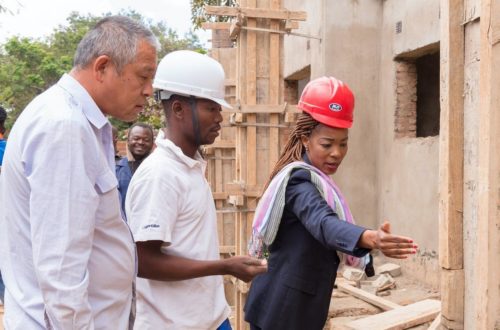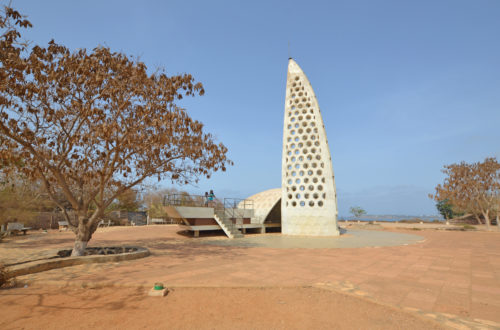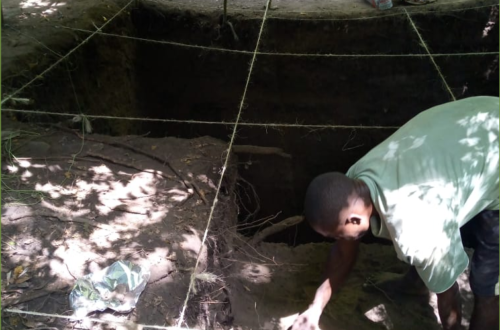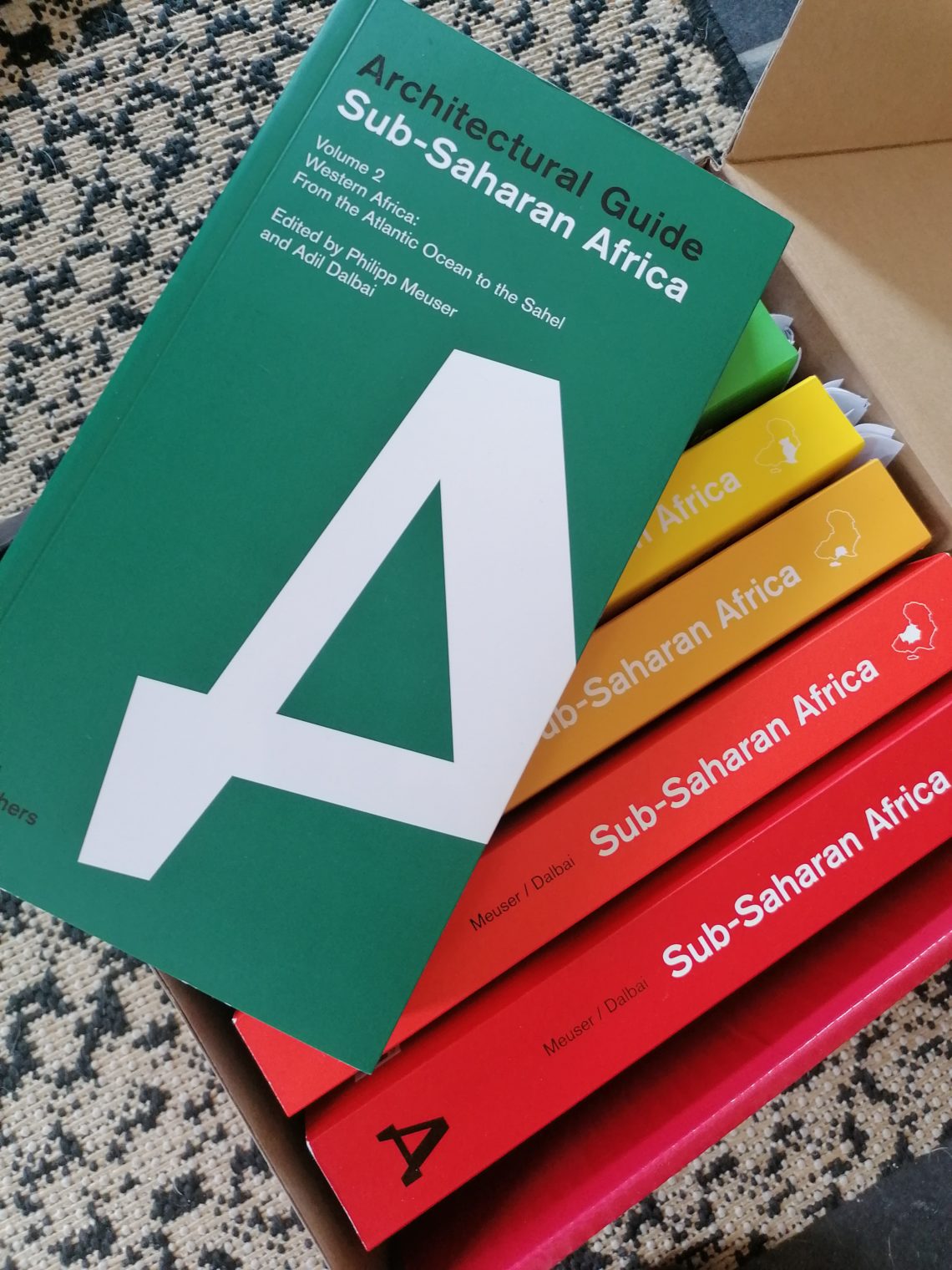
Architectural Guide Sub-Saharan Africa – Buchbesprechung/Review and Interview -ger/engl
Im ersten Teil der Betrachtung des neuen Architecture Guides Sub-Sahara Africa gebe ich einen Überblick über das Werk und ein Interview mit dem Herausgeber Dr. Philipp Meuser und dem verantwortlichen Redakteur, Adil Dalbai. Eine detailliertere Vorstellung der einzelnen Bände folgt im zweiten Teil.
von Hans Hofele
for english version please scroll down
Es ist ein beispielloses Unterfangen, das DOM Publishers aus Berlin da fertiggestellt hat: Mit dem Architectural Guide Sub-Saharan Africa ist eine nun eine großartige Übersicht der Architektur der Region Subsahara-Afrika gelungen. Das Werk ist schon in seinem Umfang ziemlich beeindruckend: 7 Bände, 3400 Seiten, 850 Bauwerke in 49 Ländern. Es sind sechs, nach Regionen und Länder geordnete, auch farblich unterschiedliche Bände. Vorangestellt ist ein umfassender Einleitungsband, der eine tiefer gehende Analyse über die Architektur- und Baugeschichte, der Portraits und Perspektiven einer Architektur Afrikas bietet.

Die beiden Architekten Dr. Philipp Meuser und Adil Dalbai haben gemeinsam mit über 350 afrikanischen und europäischen Autoren und Autorinnen und fast nochmal so viele Kontaktleuten und Helfern die wichtigsten Bauwerke der Länder Subsahara Afrikas dokumentiert. Allein schon die Koordination solch vieler AutorInnen kann als logistische Meisterleistung bezeichnet werden. Eine systematische, objektive Baubeschreibung dieser Region, die so noch nicht vorlag.
“Je tiefer wir da eingestiegen sind, desto klarer wurde uns: wir müssen über alle Länder berichten, müssen einen repräsentativen Querschnitt machen. Nicht nur die Highlights sondern wir wollen die gebaute Realität von Subsahra Afrika zeigen und werden deswegen auch in jedes Land gehen müssen. Fast schon detektivisch mussten wir sein, Kontakte nutzen, die weiter führen. Wir haben über Jahre die Region durch diesen Filter gesehen, Teile für das Puzzle suchen um das große Ganze herzustellen.” Adil Dalbai
Für den Berliner Verlag DOM publishers ist der Sub-Sahara Africa Guide einer von 150 Architekturführern, die sie bisher veröffentlicht haben. Keiner war aber auch nur annähernd so aufwändig wie dieser. In sieben Jahren Fleiß- und Grundlagenarbeit musste bei einer spärlichen Ausgangslage von wenig publizierter Fachliteratur mit der systematischen Arbeit begonnen werden. Und es hat sich gelohnt: Herausgekommen sind keine trockenen Technikführer. Das Layout, die Auswahl der Bilder, die Struktur der Beiträge und nicht zuletzt die Sprache, laden ein, sich auch ohne spezifischen Kenntnisse in die Bauwerke der einzelnen Länder zu vertiefen. Im Grunde genommen funktionieren sie auch als Reiseführer, machen Lust an Orte zu fahren und sich selbst ein Bild zu machen. An vielen Orten sind die Gebäude zum ersten Mal überhaupt dokumentiert und beschrieben. Darüber hinaus gibt es auch praktische Aufklärung, wie man zum Beispiel eine Lehmhütte in einem bestimmten regionalen Stil baut.

“Unsere Philosophie ist, dass wir ein Land, eine Region über Architektur erklären. Wenn man das Planen und Bauen in einer Region oder Kultur versteht, versteht man auch das Land.” Philipp Meuser
Die 850 Bauwerke werden in Kurzportraits vorgestellt und eingeordnet. Zahlreiche Fotos, Skizzen und Pläne veranschaulichen die Architekturstile und Bauweise. Gezeigt werden nicht nur moderne Bauten, wie sie von Luanda bis Dar-es-Salaam nun in allen Großstädten Afrikas entstehen. Bei manchen wird auch die gesellschaftspolitische Dimension deutlich, wenn vom Nyayo House, einem mehrstöckigen Bürokomplex in Nairobi ,von der Gleichzeitigkeit von Büroleben und Folterkellern im selben Gebäude erzählt wird. Das Gebäude als Angstzentrum.
Nie stehen Gebäude nur für sich. Die riesigen Kathedralen in Senegal und Ghana in Westafrika sind Ausrufezeichen. Und es gibt immer wieder Grund zu Staunen: denn sich mit der Baukunst zu befassen ist immer auch eine Reise durch Geografie und Gesellschaftsgeschichte. Das gilt für Afrika umso mehr, prallen doch hier neben originär afrikanischen auch europäische und asiatische Einflüsse zusammen. Einflusssphären werden sichtbar gemacht, Postkoloniales oder Neokoloniales Denken, Demokratie und Diktatur, Armut und Reichtum, Heroischer Aufbruch, stilles Gedenken.

Es gibt koloniale Architekturhighlights wie zum Beispiel in Eritrea, das durch italienische Einflüsse geprägt ist. Da gibt es die Epoche der stolzen Bauten aus der Unabhängigkeitswelle der Sechziger und Siebziger Jahre mit ihren Repräsentationsbauten und Denkmälern. Accra und Windhuk sind solche Beispiele. Dann wiederum werden sogar die baulichen Besonderheiten von Wasser-und Toilettenbauten gezeigt. Elementar in prekären Wohnverhältnissen, wie es sie in fast allen Ländern der beschriebenen Regionen gibt. Auch traditionelle Bauten aus Lehm und Holz sind dokumentiert. Und ihre Transformation und Einflussnahme in die moderne Architektur. Es ist die Stärke des Architekturführers, dass er sich weder dem Glitzer der Hauptstädte noch dem Retrochic des Tropicalism alleine verschreibt. Möglichst umfassend oder mindestens repräsentativ sollte die Auswahl der Gebäude sein. Die ganze Stärke zeigt sich in der Einbindung lokaler Architekten als Autoren. Für die Koordination dieser wertvollen Ressourcen ist Adil Dalbai verantwortlich.
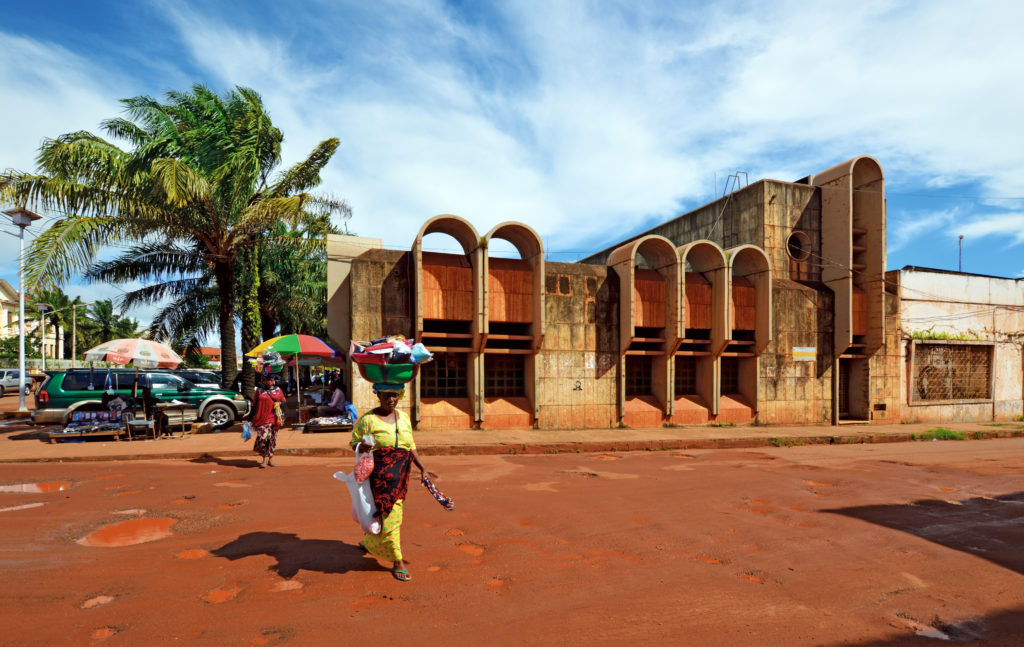
Das Interview mit Dr. Philipp Meuser und Adil Dalbai
Hans Hofele (HH): Ich bin selten so begeistert von Sachbüchern, aber diese sieben Bände sind ja ein regelrechtes Ereignis. Knapp 3400 Seiten über 300 Autorinnen, die 49 Länder abdecken. Wie schafft man es, solch ein werk zu realisieren? Wie geht man solch ein Projekt an?
Dr. Philipp Meuser (PM): Ein solches Projekt zu realisieren geht nur, wenn Sie ganz viel Geduld mitbringen und wenn Sie einen Mitarbeiter haben, der nicht auf halber Strecke aufgibt. Und da es ein frei finanziertes Projekt war, ging das freilich nur mit viel Elan und Enthusiasmus. Parallel zur redaktionellen Arbeit waren wir in in Mali, Burkina Faso und Ghana auch in Planungsprojekten engagiert. Die Bücher sind der Notwendigkeit erwachsen, dass es nur wenig architekturbezognene Literatur über die Region gibt.
Wir haben bereits 2014 mit der Recherche angefangen und sehr schnell festgestellt, dass wir es nicht auf Westafrika beschränken können und ein Netzwerk von Autoren und Autorinnen aufgebaut. Aus 50 wurden 100 und am Ende über 300, mit allen Akteuren zusammen sind es sogar 600 Personen, die mit Fotos, Reisetips und Kontakten geholfen haben.
Adil Dalbai (AD): Man musste auch die Bereitschaft zum ständigen Transformieren mitbringen. Das Projekt hat sich während der Jahre mehrfach geändert. Am Anfang war es sogar nur als einbändiges Projekt gedacht, als kleiner Überblick. Doch je tiefer wir da eingestiegen sind, desto klarer wurde uns: wir müssen über alle Länder berichten, müssen einen repräsentativen Querschnitt machen. Nicht nur die Highlights sondern wir wollen die gebaute Realität von Subsahra Afrika zeigen und werden deswegen auch in jedes Land gehen müssen. Wir mussten schon fast detektivisch sein, Kontakte nutzen, die weiter führen. Wir haben über Jahre die Region durch diesen Filter gesehen, mussten Teile für das Puzzle suchen um das große Ganze herzustellen.
HH: Man konnte also gar nicht auf vorhandene Unterlagen zurückgreifen? Es scheint mir wie eine Expedition in die Architektur zu sein? Herr Meuser, ich habe gelesen, es gab nur einen halben Regalmeter über einen ganzen Kontinent? War es also auch Absicht, ein Standardwerk für diese Region zu schaffen?
PM: Der halbe Regalmeter hat sich inzwischen verzehnfacht. Aber zu Beginn war in der Tat nur sehr wenig in unserer Bürobibliothek vorhanden. Es war schon die Idee, so etwas wie ein Standardwerk zu schaffen. Ich möchte das nicht so nennen, widerspreche aber auch nicht, wenn Sie das sagen.
AD: Wir hatten vielleicht nicht den Anspruch, das Standardwerk zu schaffen aber schon auch Grundlagenforschung zu betreiben, indem wir zumindest was die moderne Architektur betrifft , für einzelne Länder Gebäude zum ersten mal dokumentieren. Da gab es oft nichts Relevantes in der Literatur.
PM: Das Buch, das wir herausgeben wollten, gab es in dieser Form noch nicht. Das ist uns schnell klar geworden – mit hoher Motivation, aber auch mit Zweifeln. Denn es gibt unter Verlegern einen Witz: Ein Autor schlägt dem Verlag ein Buchthema vor mit der Begründung: “Darüber gibt es noch nichts!”. Und der Verleger antwortet: “Vielleicht gibt es einen Grund!”
Aber nennen wir die Herausforderung: Einerseits die über 2.000 Ethnien in Ländern, die Grenzen haben, die Kolonialmächte gezogen haben. Ignorierende Grenzen, die durch ethnische Regionen hindurch gehen. Da haben wir als Europäer auch eine gewisse Verantwortung. Andererseits haben wir auch einen etwas distanzierteren Blick und sehen vielleicht von außen Zusammenhänge, die afrikanische Autoren nicht so sehen oder anders betrachten würden. Wir versuchen eine Objektivität zu schaffen, wissen aber, wie schwierig das ist.
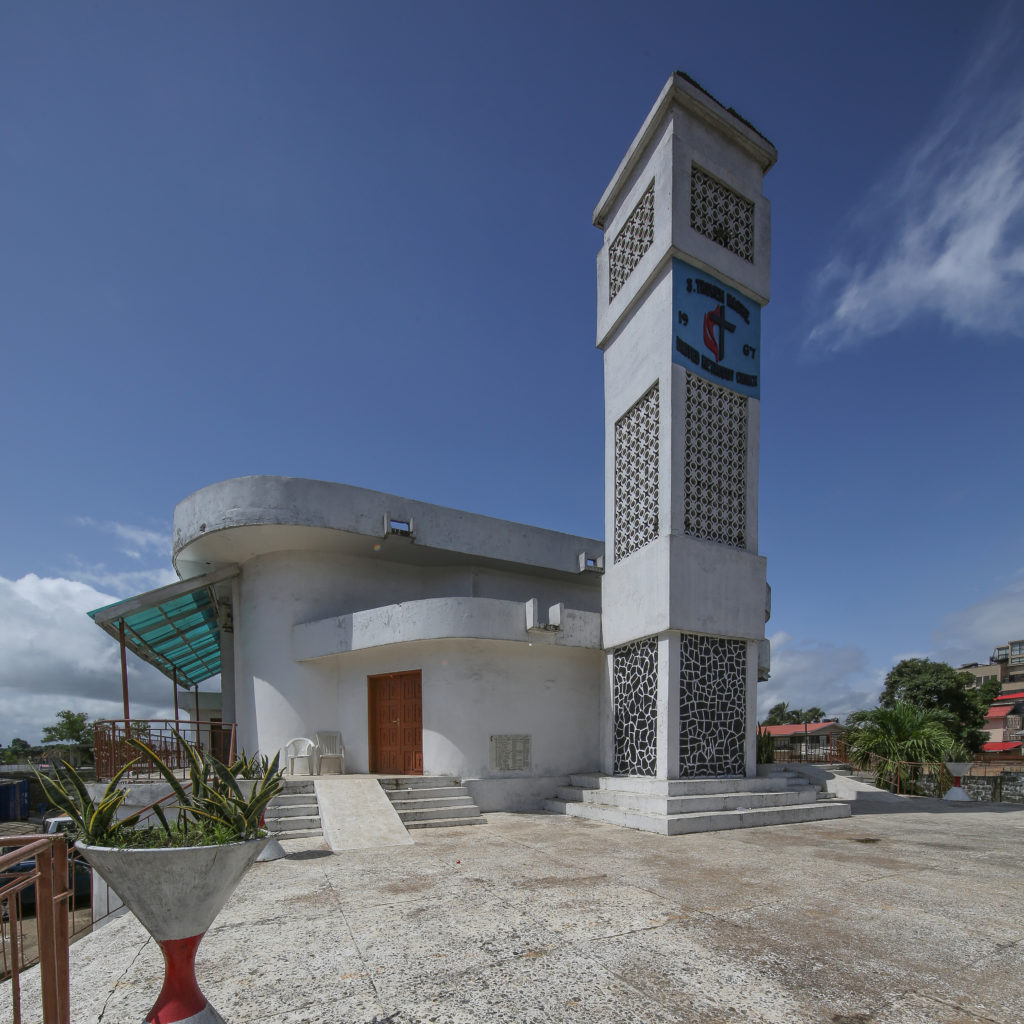
HH: Beim Lesen habe ich gemerkt, die Bände sind viel mehr als nur Architekturführer sondern auch gewissermaßen Kultur- und Gesellschaftsbetrachtung. Ist das ihre spezielle Art, Architekturführer zu machen?
PM: Wir haben ja schon über 150 Architekturführer gemacht. Das Afrikaprojekt ist mit Abstand das umfangreichste Projekt. Unsere Philosophie ist, dass wir ein Land mit Hilfe von Architektur erklären. Wenn man das Planen und Bauen in einer Kultur versteht, versteht man auch das Land. Da geht es von Verflechtungen im Wirtschaftswesen bis hin zur Frage, wie wohnen die Menschen und wie versuchen sie ihre Häuser zu gestalten. Immerhin zählt Subsahara 49 Länder, so viele Europa. Ein Europaführer würde wohl auch sehr heterogen ausfallen.
HH: War es bisher die Arroganz des Westens, dass es bis zum Jahr 2021 bedurfte, dass ein Architekturführer über afrikanische Länder erscheint?
AD: Es gibt ein Zitat von Hegel, das besagt, dass Afrika keine Geschichte habe. Diesem Zitat, diesem Vorurteil sind wir in der älteren Literatur öfters begegnet. Doch mittlerweile dürfte auch dem Letzten klar geworden sein, dass es ein Kontinent mit seiner sehr reichen Kultur- und Baugeschichte. Aber allein schon, dass man es extra betonen muss, spricht von einer gewissen Arroganz gegenüber Afrika.
HH: Wie entstand die Auswahl der Objekte, wie entsteht Objektivität?
AD: Es ist eine Stärke des Projekts, das wir auch die Vielfalt und die Widersprüche die diesen Kontinent aus machen, neben einander stehen lassen.
Zum Beispiel Kenia, es gibt einen Artikel über die Wolkenkratzer und auch das Selbstbild das sie transportieren. Auch das Nebeneinander von Glitzer und Slums von Golfplatz und Elendsviertel. In Nigeria haben wir die Megaprojekte mit den Glitzerfassaden und die Dorfgemeinschaften auf dem Wasser nebeneinander. Wir zeigen also weder nur Hochglanz noch nur Elend. Die Objektivität zeigt sich auch im Nebeneinander der Beiträge im Buch. Dort gibt es durchaus auch subjektive, persönliche Beiträge. In der Summe dieses Nebeneinanders entsteht so eine Gesamtschau der baulichen Realitäten in Afrika. Das war uns wichtig und auch unser Anspruch.
HH: Sprechen wir über die Wahrnehmung der Architekturleistung in Afrika. Sind ihnen überall die Türen geöffnet worden oder gab es auch Schwierigkeiten?
AD: Es gab durchaus auch Kontroversen und in manchen Länder auch eine gewisse Kultur der Heimlichtuerei. Wozu die Informationen herausgeben? Wofür? Fotos? Da mussten wir viel Überzeugungsleistung bringen, dass wir ausschließlich für das Buchprojekt arbeiten und keine sonstigen Ziele verfolgen. Pure Architekturdokumentation war einigen suspekt. Eine offene Architekturdiskussion ist nicht überall selbstverständlich.
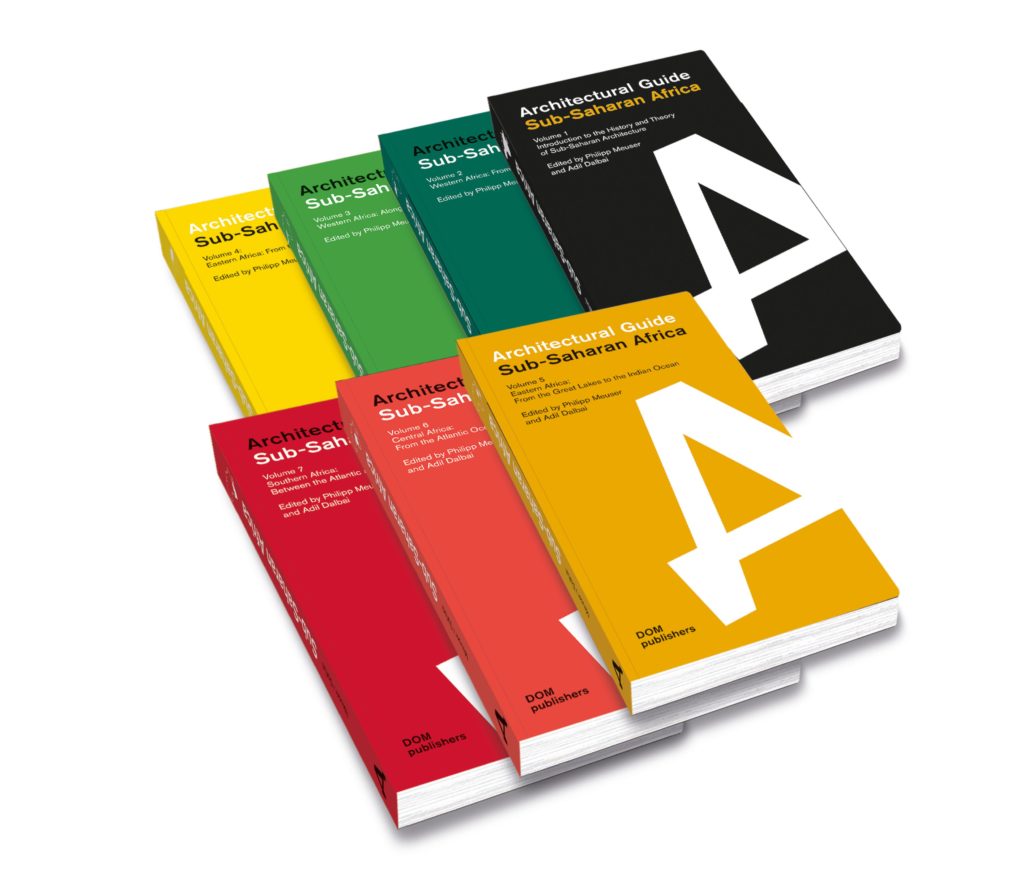
PM: In Conakry hatten wir zum Beispiel Probleme mit der Polizei. Nach dem Fotografieren von Gebäuden hat uns die Polizei festgesetzt und befragt.
AD: Ich wurde auf der Polizeiwache in Conakry ebenfalls eine Stunde befragt, während man im Nachbarland Guinea-Bissau ungehindert den Präsidentenpalast und den Gerichtshof fotografieren konnte. Zwei benachbarte Länder, unterschiedliche Auffassungen, auch was die Recherchemöglichkeiten angeht.
HH: Wie stark ist die Betrachtung der Architekturleistung von unserem westlichen Denken geprägt?
PM: Allein schon die Tatsache, dass wir eine Auswahl von Bauten vornehmen und ganz explizit den Namen des Architekten nennen, ist schon eine westliche Herangehensweise. es ist unsere Methode, ein Gebäude mit einem Entwurfsverfasser zu verbinden. Bei indigenen Bauten gibt es aber keine Entwurfsverfasser, da ist es eher ein Kollektiv. In Europa hat sich schon früh eine Arbeitsteilung im Planen und Bauen herausgebildet, angefangen mit den Zünften und dem Handwerkswesen. In Afrika ist es bis heute oft so, dass die Dorfgemeinschaft gemeinsam die Häuser baut.
AD: Es gibt Gebäude, bei Lehmbauten zum Beispiel, da wissen sie gar nicht mehr , wie oft es schon erneuert wurde. Oft steht nur der Kern im Original, die äußeren Schichten wurden aber aus Erhaltungs- und Witterungsgründen schon zigfach erneuert. Auch der Denkmalschutz müsste hier neu gedacht werden.
HH: Mir ist aufgefallen, dass es gemessen an der Größe des Gebiets, 49 Länder, die städtebaulichen Projekte, Housing Projekte nicht mit dem Bevölkerungswachstum schritthalten. Wie kommt das?
PM: In Ghana, Nigeria und Äthiopien gibt es beispielsweise Projekte des Massenwohnungsbaus. Es gibt die aber überall die Notwendigkeit, solche Haustypologie zu entwickeln. Oft fehlt aber bei Bauministerien das Bewusstsein, Projekte dieser Art anzustoßen. Viel wird dem natürlichen Wachstum oder aber ausländischen Investoren aus Europa oder China überlassen. Diese übertragen dann ihre eigenen Modelle in die afrikanischen Städte.
HH: China investiert in Afrika im großen Stil. Das wird auch in den Architekturführern deutlich. Projekte wie der Komplex der Afrikanischen Union, Häfen, Straßen Gleise und Bahnhöfe zum Beispiel in Kenia. Hat Europa in Afrika hinsichtlich der Bautätigkeit China das Feld überlassen?
AD: In französischsprachigen Ländern Westafrikas wird der Bausektor noch viel von französischen Konzernen dominiert. Die chinesischen Projekte sind staatlich subventioniert oder im Rahmen von staatlichen Kooperationen entstanden.

PM: China hat eine Regierung, die mit einer einzigen Stimme spricht. Wenn beispielsweise beschlossen wird, dass in Kenia zehn Bahnhöfe gebaut werden, dann werden die auch gebaut. Es steht ja ein klares wirtschaftliches und politisches Interesse dahinter – wie früher in der Kolonialzeit: Über Straßen und Schienen soll das Hinterland erschlossen werden, um Ressourcen wie Bodenschätze oder Waren besser ausbeuten zu können. Diese Strategie verfolgt Europa nicht mehr. Europa hat ein Interesse, die Lebensbedingungen auf dem Kontinent zu verbessern, auch um Migrationen zu verringern.
AD: Die großen Projekte sind natürlich deutlich sichtbarer. Wenn auch langsam ein Umdenken stattfindet und nicht mehr jedes Großprojekt in Afrika angenommen wird und mehr auf Balance geachtet wird.
HH: Hat Afrika viele gute Architekten und sind diese den Aufgaben der Zukunft gewappnet?
PM: Das Bevölkerungswachstum in Afrika wird dazu führen, dass sich eine junge und starke Generation herausbilden wird. Zum Teil ist die auch schon sichtbar und teilt ihre Ansichten etwa zu Ressourcenschonung. Diese junge Generation bekommt in Kürze auch Entscheidungsbefugnis. Das ist ja nicht wie in Europa, wo man als Architekt erst 50 werden musss, um wahrgenommen zu werden. In Afrika ist 50 Prozent der Bevölkerung unter 18 Jahren. Da ja viel mehr gebaut und geplant werden muss, wird es also nur eine Frage der Zeit sein, bis diese junge Generation Verantwortung übernimmt. Die großen Leuchtturmprojekte werden aber wohl weiterhin von global agierenden Firmen realisiert.
AD: Bei den jungen afrikanischen Architekten steigt das Bewusstsein, das auch auf lokale Lösungen zurückgegriffen werden muss. Dass auch afrikanische Baugeschichte zählt. Es gibt mehr afrikanische Architekturschulen und Fakultäten, die gegründet werden. Aber immer noch nicht genug, um den Bedarf zu decken. Der Architekturführer hat jedenfalls auch den Austausch angeregt. Jetzt kann man schauen, was gibt es im Land oder im Nachbarland für Bauwerke. Eine Website soll entstehen, auf der sich Architekten austauschen können. So kann das Projekt Subsahara Afrika auch jenseits der Buchform weiter gehen.
©cultureafrica.net 2021
Alle Bilder, wenn nicht anders angegeben: ©Philipp Meuser und Adil Dalbai
Architectural Guide Sub-Saharan Africa
Edited by Phillip Meuser und Adil Dalbai
3500 Seiten, 7 Bände, 148€
Verlag: DOM publisher
:::English Version:::::::::::::::::::::::::::::::::::::::::::::::::::::::::::::::::::::::::::::::::::::::::::::::::::::::::::::::
In the first part of the review of the new Architecture Guide Sub-Sahara Africa, I give an overview of the work and an interview with the publisher Dr. Philipp Meuser and the responsible editor, Adil Dalbai. A more detailed presentation of the individual volumes follows in the second part.
It is an unprecedented undertaking that DOM Publishers from Berlin has completed: With the Architectural Guide Sub-Saharan Africa, a now a great overview of the architecture of the region of Sub-Saharan Africa has succeeded. The work is already quite impressive in its scope: 7 volumes, 3400 pages, 850 buildings in 49 countries. There are six volumes, arranged by region and country, also in different colors. Preceded by a comprehensive introductory volume, which offers a more in-depth analysis on the architectural and building history, portraits and perspectives of an architecture of Africa.

The two architects Dr. Philipp Meuser and Adil Dalbai, together with more than 350 African and European authors and almost as many contact people and helpers, have documented the most important buildings in the countries of sub-Saharan Africa. The coordination of so many authors alone can be described as a logistical masterpiece. A systematic, objective building description of this region, which was not available before.
“The deeper we got into it, the clearer it became to us: we have to report on all countries, we have to make a representative cross-section. Not just the highlights, but we want to show the built reality of sub-Saharan Africa and therefore we will have to go to every country. We had to be almost detective-like, using contacts that lead further. We’ve seen the region through this filter for years, looking for pieces to the puzzle to make the big picture.” Adil Dalbai
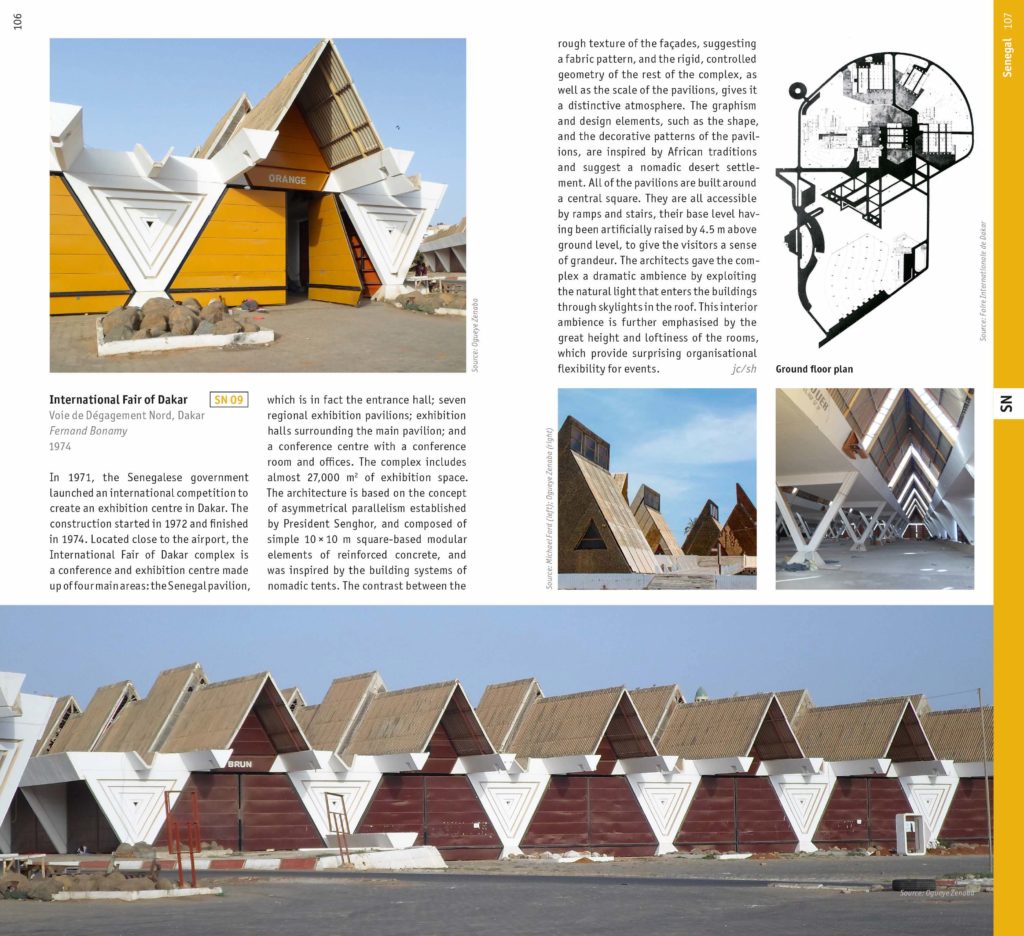
For Berlin-based DOM publishers, the Sub-Sahara Africa Guide is one of 150 architectural guides they have published to date. None, however, has been nearly as elaborate as this one. It took seven years of diligence and groundwork to begin the systematic work, with a sparse starting point of little published literature. And it was worth it: the result is not a dry technical guide. The layout, the selection of pictures, the structure of the contributions and, last but not least, the language, invite the reader to delve into the buildings of the individual countries even without specific knowledge. Basically, they also function as travel guides, making you want to go to places and see for yourself. In many places, the buildings are documented and described for the first time ever. There’s also practical education on how to build an adobe hut in a particular regional style, for example.
“Our philosophy is that we explain a country, a region, through architecture. If you understand the planning and building in a region or culture, you understand the country.” Philipp Meuser
The 850 buildings are presented and classified in short portraits. Numerous photos, sketches and plans illustrate the architectural styles and construction methods. Not only modern buildings are shown, as they are now being built in all major cities in Africa from Luanda to Dar-es-Salaam. In some cases, the socio-political dimension also becomes clear, as when the Nyayo House, a multi-story office complex in Nairobi ,is told of the simultaneity of office life and torture cellars in the same building. The building as a center of fear.
Buildings never stand alone. The huge cathedrals in Senegal and Ghana in West Africa are exclamation points. And there is always reason to marvel: because to deal with the art of building is always a journey through geography and social history. This is even more true for Africa, where European and Asian influences collide with original African ones. Spheres of influence are made visible, postcolonial or neocolonial thinking, democracy and dictatorship, poverty and wealth, heroic awakening, silent commemoration.
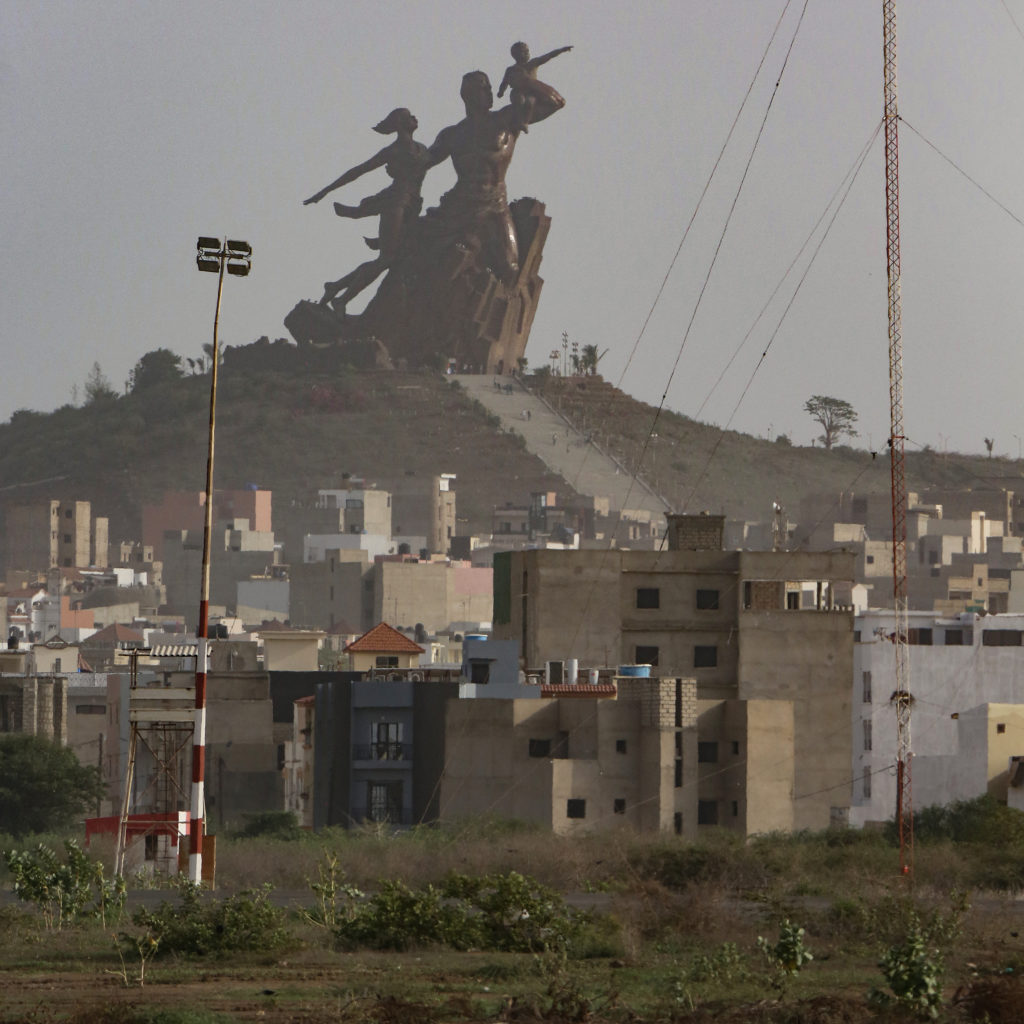
There are colonial architectural highlights, such as in Eritrea, which is characterized by Italian influences. There is the era of proud buildings from the independence wave of the sixties and seventies with their representative buildings and monuments. Accra and Windhoek are such examples. Then again even the structural peculiarities of water and toilet buildings are shown. Elementary in precarious living conditions, as they exist in almost all countries of the described regions. Traditional buildings made of mud and wood are also documented. And their transformation and influence into modern architecture. It is the strength of the architectural guide that it is not dedicated to the glitz of the capitals or the retrochic of Tropicalism alone. As comprehensive as possible, or at least representative, should be the selection of buildings. The full strength is shown in the involvement of local architects as authors. Adil Dalbai is responsible for coordinating these valuable resources.
Interview with Dr. Philipp Meuser and Adil Dalbai
Hans Hofele (HH): I am seldom so enthusiastic about non-fiction books, but these 7 volumes are a real event. Almost 3400 pages on 300 authors covering 49 countries. How do you manage to realize such a work? How do you go about such a project?
Dr. Philipp Meuser (PM): You can only do it if you have a lot of patience and if you have a collaborator who doesn’t give up halfway through, and if you stick with it while you’re still working as an architect, because that’s what we are. It is a freely financed project. So it can only be done with a lot of drive and enthusiasm. We have worked as architects in Mali, Burkina Faso and Ghana. The books grew out of the necessity that we found there was nothing or very little architectural literature about the region.
Then we started in 2014 and very quickly realized we couldn’t limit it to West Africa. Adil then built a network of authors and writers. From 50 became 100 and in the end over 300, with all the actors together there are 600 who have contributed. Who helped with photos, with travel assistance, contacts…
Adil Dalbai (AD): You also had to be willing to constantly transform. The project has changed several times over the years. In the beginning, it was even meant to be a one-volume project, a small overview. But the deeper we got into it, the clearer it became: we have to report on all countries, we have to make a representative cross-section. Not just the highlights, but we want to show the built reality of sub-Saharan Africa and therefore we will have to go to every country. We have had to be almost detective-like, using contacts that lead on. We have seen the region through this filter for years, had to look for pieces for the puzzle to make the big picture.
HH: So you couldn’t fall back on existing documents at all? It seems to me like an expedition into architecture? Mr. Meuser I read there was only half a shelf meter about a whole continent? Was it alo the intention to create a standard work for this region?
PM: The half shelf meter has now increased tenfold after all. There was only very little also with us available. That was already an idea, to create something like a standard work. I don’t want to call it that, but I don’t disagree when they say that.
AD: Maybe we didn’t want to create a standard work, but we wanted to do basic research by documenting buildings for individual countries for the first time, at least as far as modern architecture is concerned. There was often nothing relevant in the literature.
PM: There was nothing in the systematic way we wanted to do it, that quickly became clear to us. There is a joke among publishers, in which an author comes who wants to make a book about a subject, with the argument: “There is nothing about it yet!”. Says the publisher, “Maybe there is a reason!”
But let’s call the challenge: architecture about a region with over 2000 ethnicities, with countries that have borders drawn by colonial powers. Borders that go through cultural regions and ethnic regions. As Europeans, we also have a certain responsibility towards this fact. On the other hand, we also have a somewhat more distanced view and perhaps see connections from the outside that authors from the inside would not see in the same way or would view differently. We try to create an objectivity, although that is difficult.

HH: While reading, I noticed the volumes are much more than just architectural guides but also, in a way, cultural and social observations. Is that your special way of making architectural guides?
PM: We have already produced over 150 architectural guides. But the Africa project is by far the most extensive and longest project. Our philosophy is that we explain a country, a region, through architecture. If you understand the planning and building in a region or culture, you also understand the country. It’s about interdependencies in the economy of a country, all the way to the question of how people live and how they try to design their houses. After all, the region described has 49 countries, not even Europe has that many. A European guide would also be very different.
HH: Was it the arrogance of the West so far that it took until 2021 for an architectural guide to African countries to appear?
AD: There is a quote from Hegel that says that Africa has no history. We have often encountered this quote, this prejudice, in older literature. But by now it should have become clear to even the last one that it is a continent with its very rich cultural and architectural history. But the very fact that you have to emphasize it speaks of a certain arrogance towards Africa.
HH: How did the selection of objects come about, how does objectivity come about?
AD: One of the strengths of the project is that we also let the diversity and contradictions that make up this continent stand side by side.
For example, Kenya, there is an article about the skyscrapers and also the self-image they transport. Also the juxtaposition of glitz and slums of golf course and slum. In Nigeria, we have the mega projects with the glitter facades and the village communities on the water side by side. So we show neither only glossy nor only misery. Objectivity is also evident in the juxtaposition of the contributions in the book. There are also subjective, personal contributions. In the sum of this juxtaposition, an overall view of the constructional realities in Africa emerges. That was important to us, and it was also our aim.

HH: Let’s talk about the perception of architectural achievements in Africa. Were the doors opened to you everywhere, or were there also difficulties?
AD: There was definitely controversy and in some countries a certain culture of secrecy. Why give out the information? What for? Photos? We had to do a lot of convincing that we were working exclusively for the book project and not pursuing any other goals. Pure architectural documentation was suspect to some. An open discussion of architecture is not a matter of course everywhere.
PM: Much of the narrative culture in Africa is an oral narrative culture. I found it very pleasant; on location .In Conakry, for example, we had problems with the police. There, after taking pictures of buildings, the motorcycle police stopped us and questioned us.
AD: I was questioned for an hour at the police station, while in the neighboring country of Guinea-Bissau we were able to photograph the presidential palace and the court without hindrance. Two neighboring countries, different views, also in terms of research possibilities.
HH: How strongly is the view of architectural achievement influenced by our Western thinking?
PM: The very fact that we make a selection of buildings, and quite explicitly mention the name of the architect, is already a Western approach. That there is a name, a face, as the author of the design, that is our methodology. With indigenous buildings, however, there are no design authors, there it is more of a collective. If we contrast Europe, a division of labor developed early on, starting with the guilds and the crafts. In Africa, it has long been the case that the village community builds the houses together. Globally, however, the standard is already that the designer is named in the architecture.
AD: There are buildings, clay buildings for example, where they don’t even know how often it has been renewed. Often only the core is original, but the outer layers have already been renewed umpteen times for reasons of preservation and weathering. The protection of historical monuments would also have to be rethought here.
HH: I’ve noticed that measured by the size of the area, 49 countries, the urban development projects, housing projects are not keeping pace with the population growth. Why is that?
PM: In Ghana, in Nigeria and Ethiopia, there are these projects, but you have to keep an eye on the developments. There is an opportunity to develop your own typology. However, there is often a lack of awareness, for example among construction ministries, to initiate projects of this type. Much is left to natural growth or to foreign investors from Europe or China. These then bring prefabricated models to the cities.
HH: China is investing in Africa on a grand scale. This is also evident in the architectural guides. Projects like the African Union complex, ports, roads tracks and train stations for example in Kenya. Has Europe left the field to China in Africa in terms of building activity?
AD: In French-speaking countries in West Africa, the construction sector is still much dominated by French groups. The Chinese projects are state-subsidized or have come about as part of state collaborations.
PM: China, of course, has one government, one state, one vote. And if it is decided that ten stations will be built in Kenya, then they will be built. But there is also a clear interest behind it, just like in the colonial era. Roads and railways are to be used to open up the hinterland so that resources such as mineral resources can be better exploited. Europe is not pursuing this strategy. Europe has an interest in making the continent strong in order to prevent migrations. Ultimately, with the book project we are also trying to network the architects with each other and to make them heard beyond Africa.
AD: The large projects are of course much more visible. If a rethinking is also slowly taking place and not every large project in Africa is accepted anymore and more attention is paid to balance.

HH: Does Africa have many good architects and are they prepared for the tasks of the future?
PM: The population growth in Africa will lead to the emergence of a very young and strong generation. Some of them are already here, and they have modern views, including on the conservation of resources. This young generation is now also taking on decision-making functions. It’s not like in Europe, where architects have to turn 50 before they are noticed. In Africa, 50 percent of the population is under 18. Since there is a lot more building and planning to be done, it will be a normal process for this young generation to take over. The big lighthouse projects will still be done by global firms.
AD: There is a growing awareness among young African architects that local solutions must also be used. That African building history also counts. There are more African architecture schools and faculties being established. But still not enough to meet the demand. In any case, the architecture guide has also stimulated exchange. Now you can look at what kind of buildings there are in the country or in the neighboring country. A website is to be created where architects can exchange information. In this way, the Sub-Saharan Africa project can continue beyond the book.
©cultureafrica.net 2021



